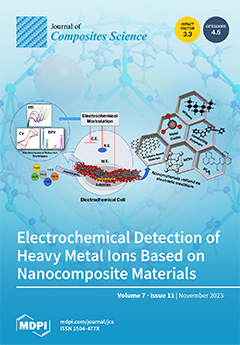Our study examined the potential of using activated carbon/nanosized cobalt oxide (AC-Co
3O
4) as a new catalytic additive to improve the efficiency of the parent ammonium nitrate/magnesium/nitrocellulose (AN/Mg/NC) composite. These findings demonstrate a significant improvement in the thermal characteristics of
[...] Read more.
Our study examined the potential of using activated carbon/nanosized cobalt oxide (AC-Co
3O
4) as a new catalytic additive to improve the efficiency of the parent ammonium nitrate/magnesium/nitrocellulose (AN/Mg/NC) composite. These findings demonstrate a significant improvement in the thermal characteristics of AN/Mg/NC/AC-Co
3O
4 compared to the initial AN/Mg/NC. Raman spectra confirmed the multilayered nature of AC. Fourier-transform infrared spectroscopy (FTIR) analysis confirmed the presence of cobalt oxide in the synthesized additive. Differential scanning calorimetry (DSC) revealed the catalytic effect of AC-Co
3O
4 on the AN/Mg/NC composite, resulting in the reduction in the decomposition peak temperature (T
max) from 277.4 °C (for AN/Mg/NC) to 215.2 °C (for AN/Mg/NC/AC-Co
3O
4). Thermal gravimetric analysis (TG) determined the overall mass losses (%) for AN/Mg/NC (70%), AN/Mg/NC/AC (75%), and AN/Mg/NC/AC-Co
3O
4 (80%). This analysis highlights the significant role of AC-Co
3O
4 in enhancing the energy release during decomposition. Moreover, the use of the differential thermogravimetric (DTG) technique demonstrated the two-step decomposition pathways attributed to the multi-component system. Finally, the combustion tests under the pressure of 3.5 MPa validated the catalytic efficiency of the AC-Co
3O
4 additive, which enhanced the burning rate (
rb) of the AN/Mg/NC/AC-Co
3O
4 composite from 10.29 to 19.84 mm/s compared to the initial AN/Mg/NC composite. The advantageous nature of the AN/Mg/NC/AC-Co
3O
4 composite with a lowered decomposition temperature can be applied in rocket propulsion systems, where the precise control of combustion and ignition processes is crucial.
Full article





